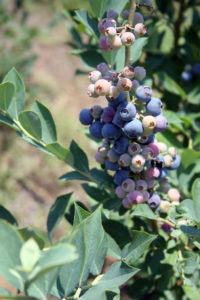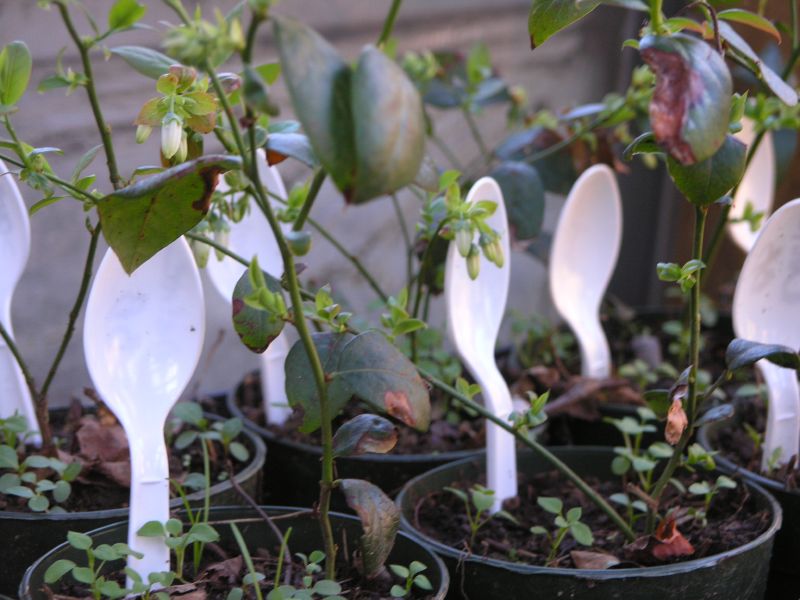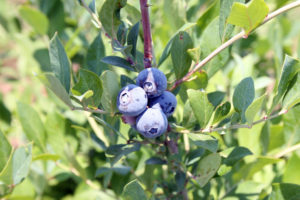Blueberry Varieties
The blueberry is native to North America. The berries have been harvested for thousands of years by indigenous peoples, and have long been picked wild for recipes of all kinds. Highbush blueberries were first bred for cultivation in New Jersey, starting in the late 19th Century, by the farmer Elizabeth White. She and the botanist Frederick Coville produced the first successful crops in 1912, and her commercial farming of blueberries started in 1916. She received many awards and citations for this.

Blueberries include a variety of species, which all have similar growing needs. The best-known types are Highbush, Lowbush, and Rabbiteye. Highbush blueberries are larger and sweeter, and the plants grow taller, generally 6-12 feet tall. Lowbush blueberries are much smaller, usually up to 2 feet tall. There are also Half-high blueberries that are crossbreeds, these are usually 3-4 feet tall. The unique Rabbiteye Blueberry can get up to 20 feet tall in some cases.
Highbush blueberries are the most common. These include the Evergreen Blueberry (Vaccinium Darrowii) and the Sweetheart Blueberry (Vaccinium Corymbosum). Highbush types are sweeter. Lowbush blueberries are found growing wild and are also a great addition to your garden. Lowbush blueberries include the Northern Blueberry (Vaccinium Boreale), the Hillside Blueberry (Vaccinium Pallidum), and of course the Common Lowbush Blueberry (Vaccinium Angustifolium). The berries are smaller, with a tangier sweet flavor. Rabbiteye blueberries are Vaccinium Virgatum (formerly Vaccinium Ashei). They are pink before they ripen, which is where they get their name. They are classically sweet blueberries.
Blueberries are a great source of vitamins C and K and are high in potassium and manganese. They are a rich source of antioxidants and are very high in fiber. Blueberries are a great low-calorie addition to your healthy diet.
Growing Blueberries
- Blueberry, Vaccinium section Cyanococcus
- Perennial
- Full sun
- Soil should be acidic, (pH between 4.5 and 4.8 – up to 5.5 for some varieties)
- Sandy, moist soil with good drainage.
- Starting from cuttings:
Cut young hardwood stems from an existing bush, 6” long in late fall
Start indoors, in containers, peat moss with potting soil on top.
Plant the stems 2” deep
Keep moist and indoors through the winter
Roots will start, transplant in late spring
- Starting from seed:
Must be cold stratified – put seeds in damp paper towels and freeze for 3 months
Start indoors, in containers, peat moss with potting soil on top.
Keep warm, keep the soil moist, keep in sunlight or with growing lights
Seeds will sprout after 6-8 weeks, transplant a few months after sprouting, in late spring
- Garden planting
Transplant to fully cover the roots, space plants 4 feet apart (48”)
- Container planting
Full-sized mature blueberry plants need large containers.
Start in smaller pots and transplant to the larger pots as they get bigger.
- Climate Zones: Highbush 3-9 Lowbush 2-7
(individual varieties are better for warmer or colder climates)

There are a few important things to remember when growing blueberries. The first thing is that they need good well-draining soil that is more acidic than soil for most garden plants, with pH between 4.5 and 5.0. Test soil acidity well before planting. If the pH is too high, lower it by adding sulfur, peat moss, or even old coffee grounds. This should be tilled into the soil in small amounts, about 3 months before planting. Test the soil once a year to make sure that it is still acidic.
The second thing is that you will need at least two different varieties of blueberries. Some of the northern highbush varieties will self-pollinate, but the yield of blueberries will be low without cross-pollinating. Many varieties will not produce berries without cross pollination.
The last main thing is that blueberries need “Chill Hours,” meaning that during the winter they need temperatures 45°F or lower for a set number of hours to produce flowers and berries in the summer. There are high-chill types that need between 800-1000 chill hours, mid-chill types that need 400-800 chill hours, and low-chill types that need 150-400 chill hours. High-chill types are best for colder climates in the north, and low-chill blueberries work better in warmer areas. Buy plants that meet the minimum chill requirements, or you will be disappointed.
Your plants need full sun, and they take a few years to start producing berries. They grow slowly, producing a bit more each year until they reach full growth about 10 years after planting. It’s important to prune blueberry bushes in the early spring, removing old wood stems. Pruning encourages new berry-producing stems. New bushes should be planted in the late spring.
Blueberry Soil Requirements

To fix a high soil pH for existing bushes, acidic fertilizers can be used, but the best solution is to scatter sulfur on the soil surface. This will work into the ground over time. A quick fix is to put a few capfuls of vinegar in a gallon of water, and water the plant with that. Vinegar will not work as a long-term solution, but watering with vinegar water for one season while adding sulfur for the long term can save a blueberry bush.
Container planting is a good option if there is difficulty managing the soil in the garden. The container needs to be large. The full-sized plants will need pots that are at least 24” deep by 30” wide, bigger is better. Using containers gives more control over the soil. Using a pot that has wheels or casters will make the pot easier to move. It’s important to keep the plants well-watered and use an acidic fertilizer once each spring before the growing season.
Azaleas, rhododendrons, and ferns are good companion plants for blueberries. These plants also do best in acidic soil and will attract pollinators. They do require less sun, so plant them in shadier areas nearby and save the sunny spots for the blueberries. Thyme is another good choice, it does fine in somewhat acidic soil, and will help deter some pests like blueberry fruit flies and maggots, as well as midges.
Blueberry Pests and Diseases
Pests for blueberries include both insects and local wildlife. Birds, squirrels, rabbits, and even deer can pose problems, depending on your area. Barriers are the best prevention for these, with netting over the plant if birds become an issue or a fence to keep critters away. Insects like midges and stem borers can cause problems. Blueberry fruit flies (and their offspring, the blueberry maggot) are sometimes an issue. Many of these can be removed or trapped. Diseases that affect blueberries include root rot and fungal infections. Another issue that comes up is a bacterial canker, which is a large growth caused by an infection in the main stems. Poorly done pruning, insect damage, or sometimes frost can damage the skin and leave the plant vulnerable. Fungal infections can be treated with an anti-fungal spray, and canker infections can be carefully cut out. The best cure is prevention, so prune your blueberries carefully, and avoid watering with an overhead spray. Ground-level watering is best for most plants, including blueberries.
Blueberries should not be harvested early, they will be too tart, and they will not ripen once picked. The fully ripe blueberry will be plump and will easily just come off the plant. Don’t wash them until right before you eat them. Chill them if you are not using them right away, this will preserve them a bit longer, but you should try to use them fairly soon, within 5 days at the latest. They can be frozen for longer storage. Spread the blueberries on a piece of parchment on an oven sheet, and put this in the freezer for 2-3 hours. They can be kept in a freezer bag for up to a year!











